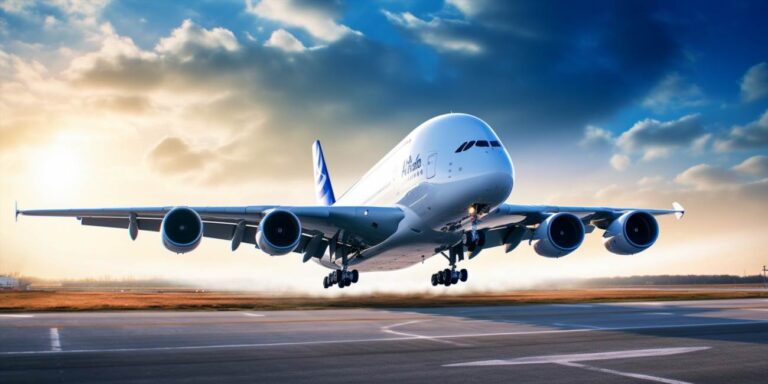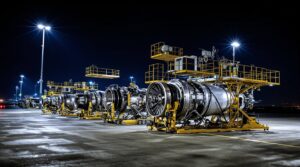The weight of an aircraft is a crucial factor that influences its performance, fuel efficiency, and overall design. In the case of the Airbus A380, its maximum takeoff weight (MTOW) is a staggering 1.2 million pounds. This mind-boggling figure includes the aircraft’s own structural weight, the weight of passengers and their belongings, cargo, and of course, the fuel required for the journey.
Breaking down the numbers further, the structural weight of the Airbus A380 itself is approximately 1.2 million pounds. This includes the weight of the airframe, engines, landing gear, avionics, and other components that make up the aircraft’s structure. This is the weight the aircraft carries even before any passengers or cargo are on board.
Now, let’s delve into the specifics of the passenger and cargo capacity. The Airbus A380 is renowned for its ability to carry an astonishing number of passengers, with a typical seating capacity of around 555 passengers in a three-class configuration. Add to this the weight of their luggage, and you have a substantial load contributing to the overall weight of the aircraft.
When it comes to cargo, the Airbus A380 has a generous cargo capacity, with the ability to carry up to 60,000 kilograms of freight. This includes everything from commercial goods to mail and other cargo. The weight of the cargo, along with the weight of the passengers and their belongings, adds to the grand total of the aircraft’s weight during takeoff.
To illustrate these figures more clearly, let’s use a table:
| Component | Weight (in pounds) |
|---|---|
| Structural Weight | 1,200,000 |
| Passengers and Luggage | Varies (Approx. 555 passengers) |
| Cargo | 60,000 |
| Total Maximum Takeoff Weight (MTOW) | 1,200,000 + Varies + 60,000 |
These numbers paint a vivid picture of the immense scale and weight-carrying capability of the Airbus A380. From its robust structural design to its ability to transport a small village worth of passengers, this aircraft truly pushes the boundaries of modern aviation.
The kerb weight of the massive airbus a380
The Airbus A380 is a marvel in aviation, not just for its sheer size and passenger capacity, but also for its impressive kerb weight. The term “kerb weight” refers to the weight of the aircraft when it is completely empty, without any passengers, cargo, or fuel on board. It is a crucial metric in understanding the structural integrity and performance capabilities of the aircraft.
The kerb weight of the massive Airbus A380 is a staggering 1.2 million pounds. This colossal figure showcases the robust engineering and materials used in constructing this double-deck, wide-body airplane. To put it into perspective, it’s like having approximately 500 mid-sized cars stacked together on the tarmac.
One of the key reasons for the substantial kerb weight is the need to support the vast infrastructure and systems required for an aircraft of this magnitude. The A380 boasts four massive Rolls-Royce Trent 900 engines, each providing an impressive thrust to propel this giant through the skies. The engines alone contribute significantly to the overall kerb weight.
Moreover, the A380’s extensive wingspan of over 79 meters (approximately 261 feet) adds to its weight. The wings are a critical component, not only for providing the necessary lift during takeoff but also for ensuring stability and control during flight. The wings house an intricate network of fuel tanks, landing gear, and various systems, all contributing to the aircraft’s overall kerb weight.
In terms of materials, the A380 utilizes advanced alloys and composite materials to maintain structural integrity while keeping weight in check. The aircraft’s skeletal framework is a masterpiece of modern engineering, striking a delicate balance between strength and weight efficiency.
While the colossal kerb weight might seem daunting, it is a testament to the engineering prowess behind the Airbus A380. The aircraft’s ability to lift off gracefully and cruise through the skies with hundreds of passengers and tons of cargo is a marvel of modern aviation technology. The kerb weight is not just a number; it is a symbol of the challenges overcome and the ingenuity invested in creating one of the largest passenger planes in the world.
Components like engines and wings adding to airbus a380 weight
The Airbus A380 stands as a marvel in aviation history, earning its place as the heaviest, double-deck, largest passenger plane ever crafted. A crucial aspect contributing to its impressive weight is the intricate network of components, where engines and wings play pivotal roles.
Let’s delve into the engines first, the powerhouses that propel this behemoth through the skies. The A380 typically employs four turbofan engines, each contributing significantly to the overall mass. These engines, usually from manufacturers like Rolls-Royce or Engine Alliance, are engineered for unparalleled thrust, allowing the A380 to conquer vast distances with ease.
The sheer size and power of these engines come with a trade-off, and that is weight. The intricate machinery, reinforced materials, and robust construction required to withstand the immense forces generated during flight contribute substantially to the aircraft’s overall mass. Each engine is a testament to aerospace engineering’s pursuit of pushing boundaries.
Now, let’s shift our focus to the colossal wings that define the A380‘s distinctive appearance. These wings span an impressive length, providing the necessary lift to carry the aircraft’s substantial weight. The wings are designed with a high aspect ratio, allowing for improved aerodynamic efficiency. However, this efficiency comes with added weight, as the wings must withstand the dynamic forces encountered during takeoff, flight, and landing.
The A380‘s wings also house various components, such as fuel tanks and landing gear mechanisms, further contributing to the aircraft’s overall weight. The intricate balance between structural integrity and aerodynamic performance necessitates a robust design, ensuring the A380 remains not only the largest passenger plane but also one of the safest and most efficient.
The Airbus A380 stands as a colossal marvel in the world of aviation, boasting a combination of technological prowess and sheer size that sets it apart. One of the key factors contributing to its monumental stature is its weight, influenced significantly by essential components like engines and wings.
Let’s delve into the intricacies of how these components add to the weight of the heaviest, double-deck, and largest passenger plane ever built.
At the core of the A380’s weight is its imposing wingspan, stretching an awe-inspiring distance to provide the necessary lift for its massive frame. The wings house powerful jet engines, each a marvel of engineering designed to propel this behemoth through the skies. The sheer number and size of these engines contribute significantly to the overall weight of the aircraft.
The engines themselves are marvels of modern engineering, incorporating advanced materials and technologies. The combination of powerful thrust requirements and the need for redundancy results in a considerable weight contribution from these propulsion systems. Each engine is a carefully balanced piece of machinery, finely tuned to ensure optimal performance during every flight.
Furthermore, the A380’s double-deck configuration, a defining feature of its design, adds an extra layer of complexity and weight. While providing unparalleled passenger capacity, the double-deck structure necessitates robust reinforcement to maintain structural integrity. The additional framework, support beams, and strengthening elements contribute to the overall mass of the aircraft.
When considering the materials used in the construction of the Airbus A380, a delicate balance between strength and weight comes into play. The aircraft incorporates advanced lightweight materials where possible, but the sheer scale of the structure requires the use of sturdy materials that inevitably contribute to its overall weight.
Fully loaded operating weight of giant a380 passenger jet
The Airbus A380, often dubbed as the “king of the skies,” is a colossal engineering marvel that pushes the boundaries of modern aviation. Weighing in at a staggering 1.2 million pounds, its Maximum Takeoff Weight (MTOW) sets the stage for its grandeur. This mammoth aircraft is a testament to human ingenuity, with its ability to carry a whopping 1.2 million pounds of cargo, passengers, and fuel combined.
One of the critical aspects of the A380’s operations is its maximum landing weight. As it gracefully descends from the heavens, this behemoth can touch down with a weight of up to 1.2 million pounds, ensuring a smooth and controlled landing. This capability is a result of advanced engineering and meticulous design, allowing the A380 to handle its immense mass with finesse.
When it comes to fuel, the A380 boasts a jaw-dropping fuel capacity, setting it apart in the realm of long-haul flights. Its max fuel capacity reaches astronomical figures, enabling it to traverse vast distances without the need for frequent refueling stops. This feature is a game-changer for airlines looking to connect distant corners of the globe efficiently.
To comprehend the scale of the A380’s capabilities, let’s break down these numbers further. Picture a table that encapsulates the essence of its specifications:
| Maximum Takeoff Weight (MTOW) | 1.2 million pounds |
| Maximum Landing Weight | 1.2 million pounds |
| Maximum Fuel Capacity | Astounding figures |
These figures not only showcase the A380’s prowess but also highlight its versatility in handling diverse operational requirements. The ability to balance such colossal weights during takeoff, landing, and sustained flight is a testament to the cutting-edge technology that propels this giant through the skies.






